My favorite way to prepare chicken for salads or as a super easy main dish, this cast iron skillet chicken breast is full of flavor and ready without a lot of fuss. Delicious and easy. What could be better?
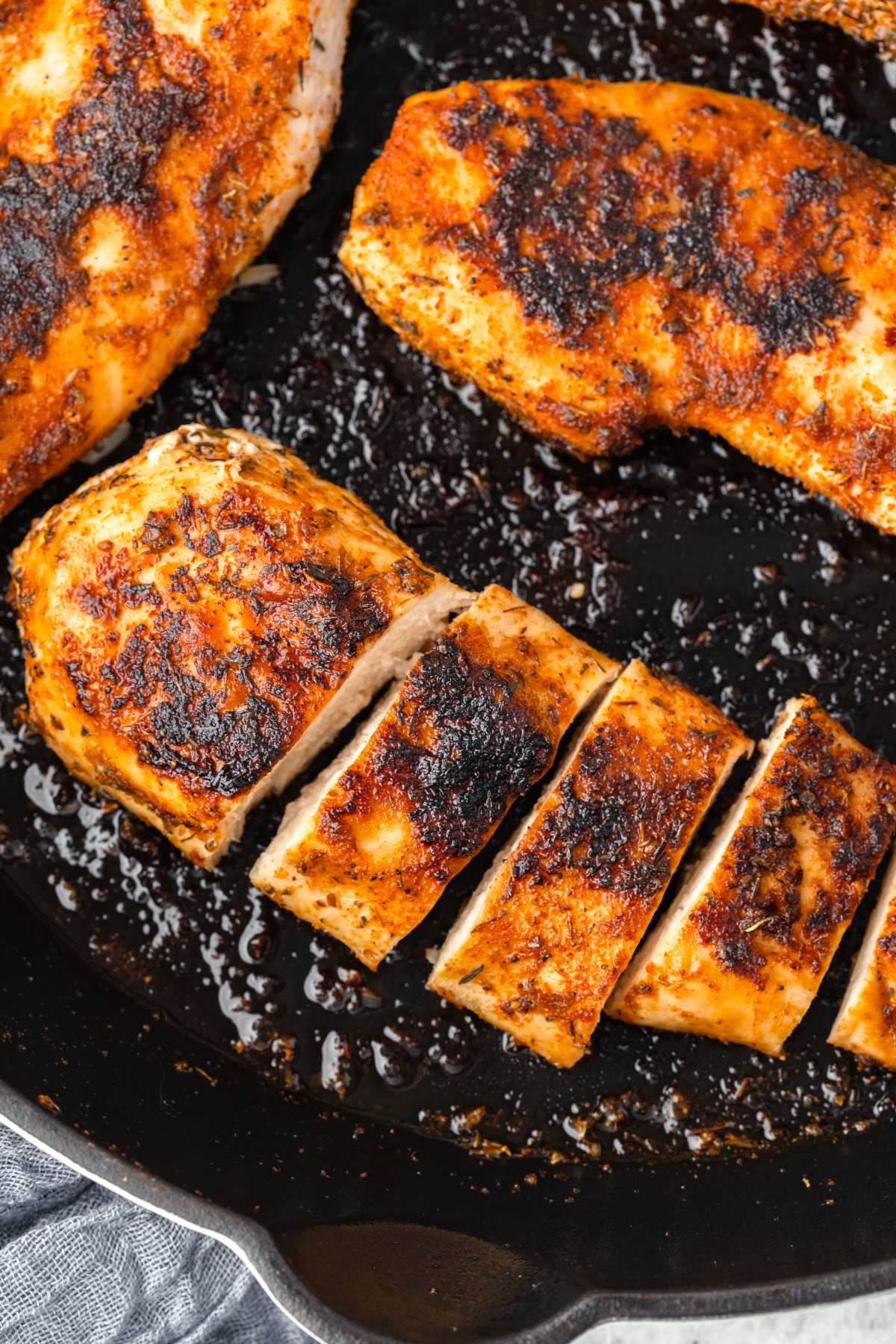
Chicken recipes often pretend to be easy but then you have to chop up the chicken, mix it with other stuff, and (horrors) turn it into a complicated casserole. Not today. We’re making a simple but truly delicious rub and then letting our cast iron skillet do the hard work of blackening the chicken while keeping it moist and juicy. For whatever reason, my pickiest eaters love this recipe. And that’s fine with me.
Ingredients and Tools You’ll Need
This rub uses very basic ingredients that I know you have on hand. And if you don’t, you should!
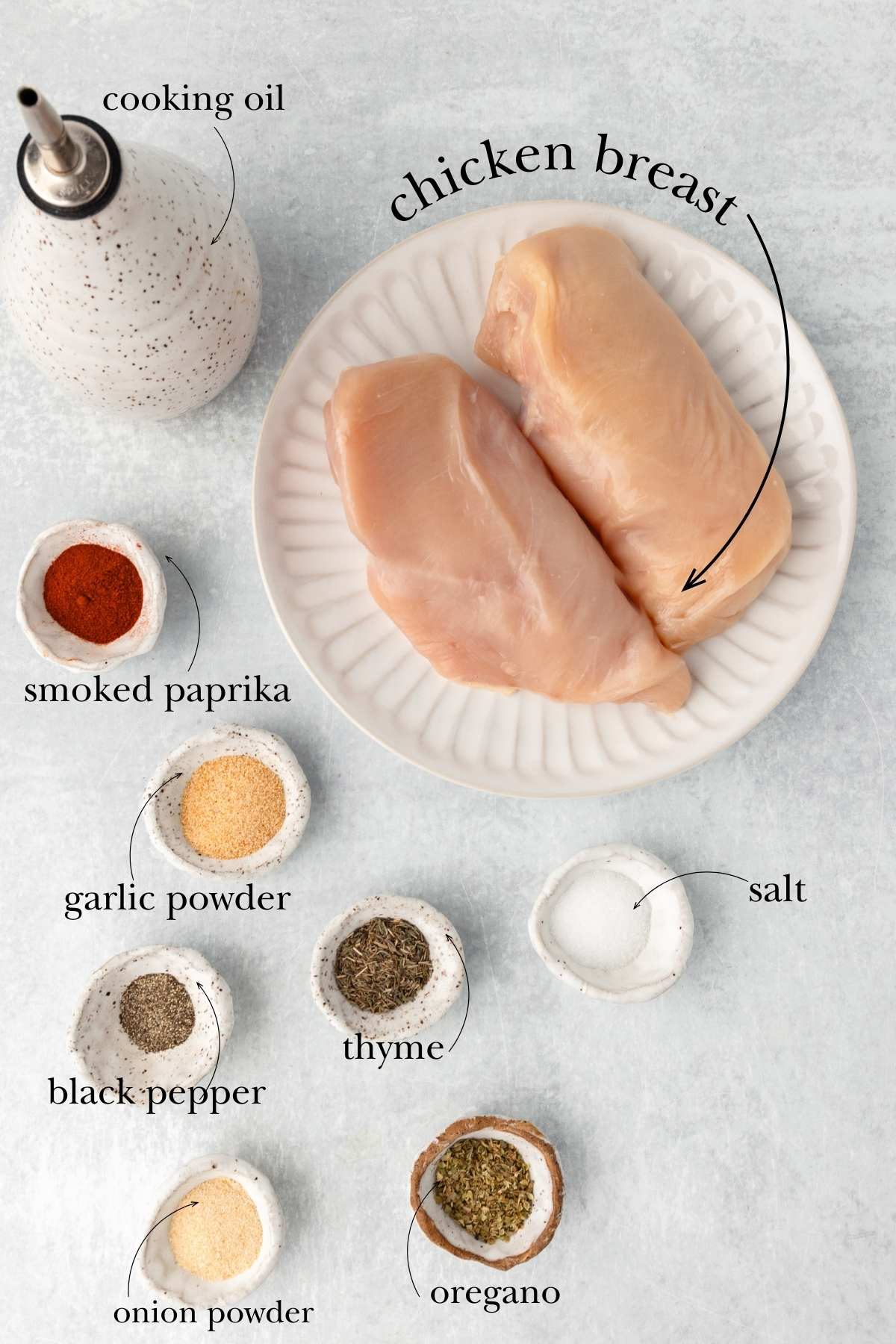
- 2 large boneless, skinless chicken breasts
- 2 tablespoons avocado oil (you can use vegetable oil too, but I don’t recommend olive oil as you’ll smoke up your kitchen!)
- 1 tablespoon smoked paprika
- 1 teaspoon dried thyme
- 1 teaspoon dried oregano
- 1 teaspoon garlic powder
- 1 teaspoon onion powder
- 1 teaspoon salt
- ¼ teaspoon black pepper
How to Make Cast Iron Chicken Breast
This is easy enough for even beginning cooks. Just don’t skip steps.
Prep the Chicken (Slice and Pat Dry)
Let’s start by creating those perfect thin cutlets. Place a chicken breast flat on your cutting board and hold it steady with your palm. With your sharpest knife, carefully slice horizontally through the middle. This gives you two evenly sized pieces that’ll cook quickly and evenly. Repeat with the second breast, and you’ll have four perfect cutlets ready to go.
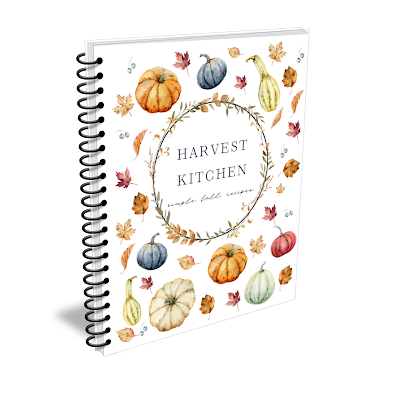
FREE FOR SUBSCRIBERS
Fall Harvest Cookbook
Subscribe (free!) to my newsletter to receive this PDF + dozens of others in my printable library. You’ll also get emails you’ll truly love, with a weekly meal and so much more.
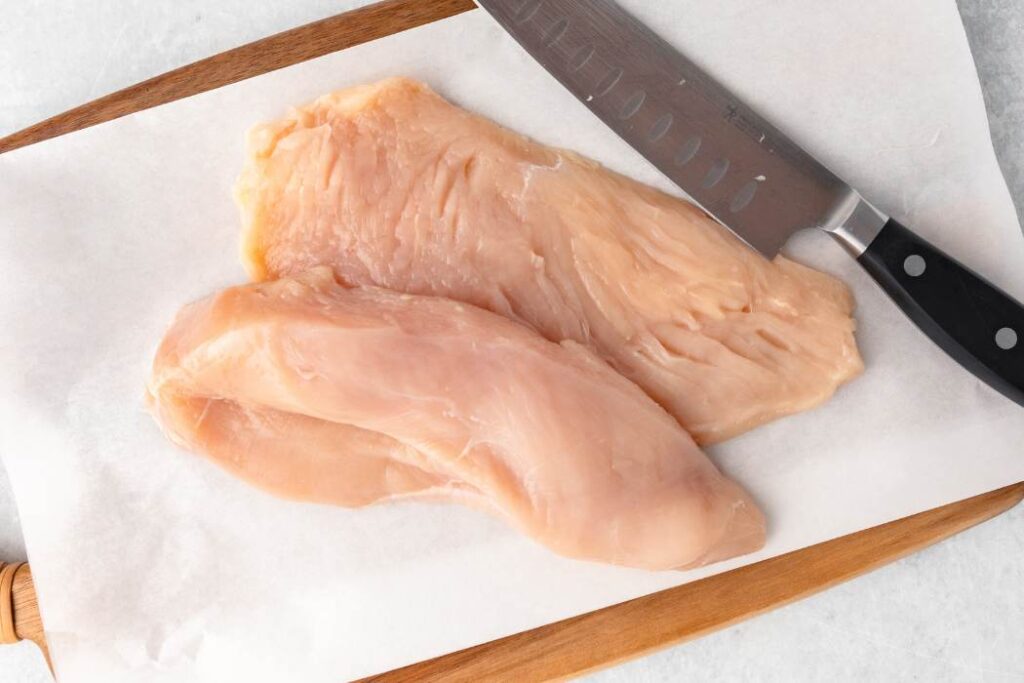
Now grab some paper towels and pat the chicken pieces until they’re completely dry. Any moisture on the surface will create steam in the pan instead of that gorgeous sear we want. Take your time here, it really makes a difference.
Make the Seasoning and Season the Chicken
In a small bowl, mix together all the spices. The smoked paprika (which gives that signature smoky flavor), thyme, oregano, garlic powder, onion powder, salt, and pepper. Give it a good stir to make sure everything’s well combined.
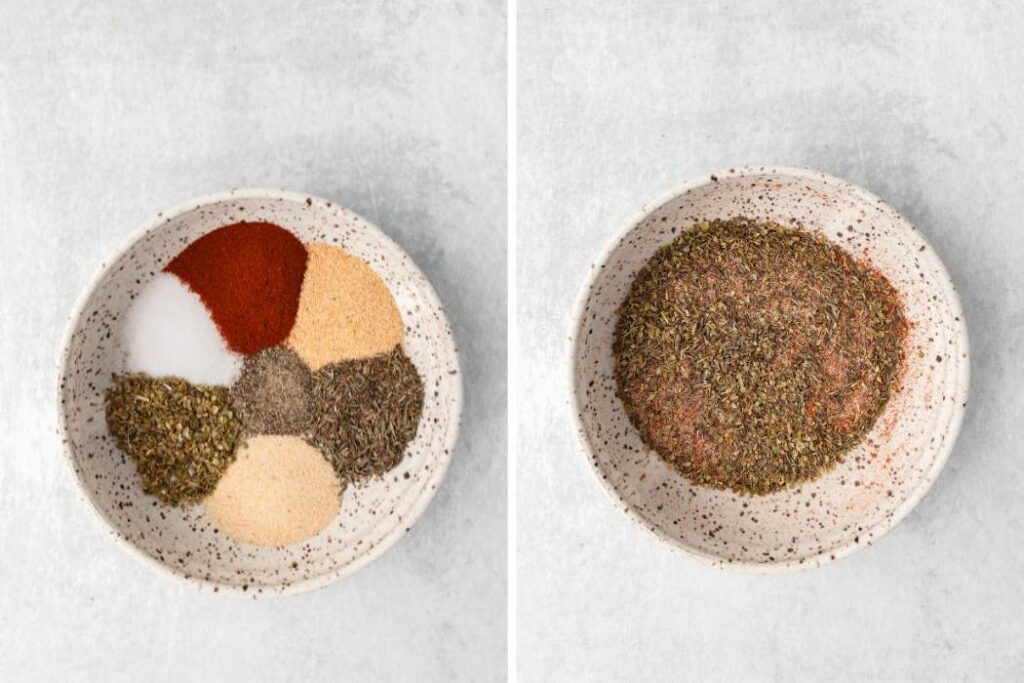
Now for the fun part! Sprinkle that seasoning blend over both sides of each chicken piece. Don’t be shy here. You want a nice, even coating.
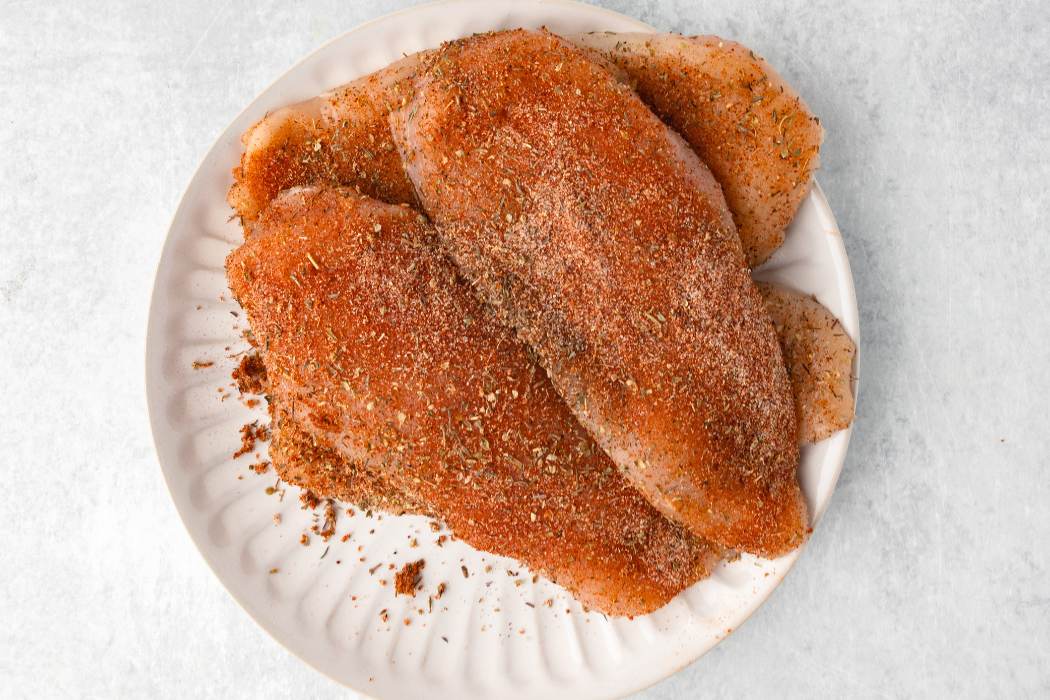
Use your fingers to gently press the spices into the meat so they stick better. It might look like a lot of seasoning, but trust me, this is what creates that incredible flavor crust.
Heat the Pan, Then Add the Oil
A super hot pan is non-negotiable for perfect blackened chicken! Place your cast iron skillet over medium-high heat and let it get properly hot. About 5 minutes. You want that pan hot before the chicken goes anywhere near it. If you’re not sure it’s hot enough, sprinkle a few drops of water on the surface. They should sizzle and disappear immediately.
Once your pan is properly heated, add that avocado oil and swirl it around to coat the bottom. The oil should shimmer right away. That’s how you know your pan is at the perfect temperature.
Cook
Carefully lay each seasoned chicken piece in the hot oil. If you don’t hear a sizzle, your pan isn’t hot enough! Let the chicken cook undisturbed for 3-4 minutes. Resist the urge to peek, flip, or move it around. That contact with the hot pan is creating your flavor crust. You’ll know it’s ready to flip when it releases easily from the pan.
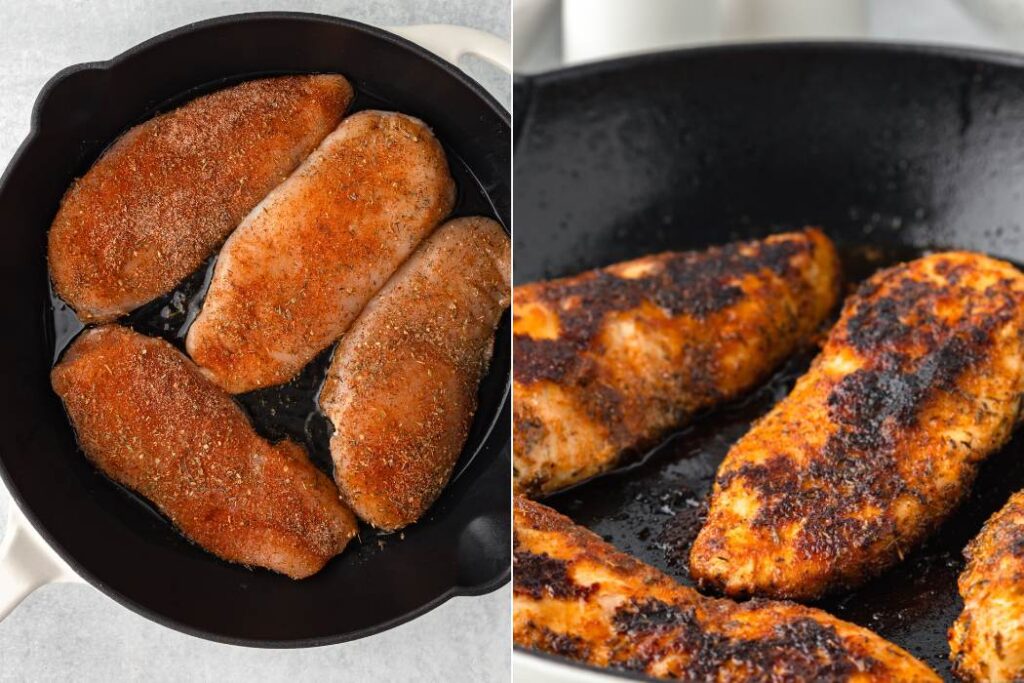
Once that first side has a gorgeous dark (not burnt!) crust, carefully flip each piece over. The second side will need about the same amount of time. 3-4 minutes. If you have a meat thermometer (and I highly recommend one for chicken), you’re looking for an internal temperature of 165°F.
Rest briefly
Transfer to a clean plate and (this is important!) let it rest for about 3 minutes. Your patience will be rewarded with juicier chicken.
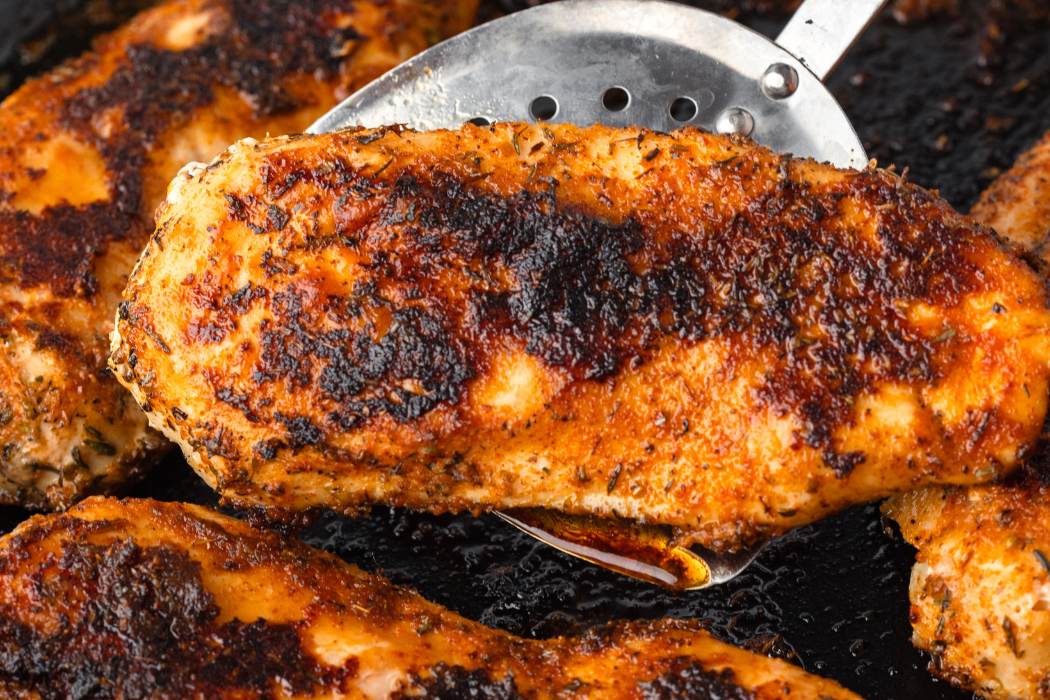
You can it eat it right away or store whole or sliced.
Storage Instructions
This chicken keeps beautifully in an airtight container in the fridge for up to 3 days, making it perfect for meal prep. When reheating, a quick minute in the microwave works, but I actually prefer to eat the leftovers cold.
You can mix the spice blend and store it in a jar for up to 3 months. You can also season the chicken up to 8 hours ahead and keep it covered in the refrigerator until you’re ready to cook.
What to Serve with Cast Iron Chicken
- Serve with creamy mashed potatoes and steamed green beans for a simple, satisfying dinner.
- Top a large green salad with sliced blackened chicken for a protein-packed meal.
- Slice the chicken and serve in warm tortillas with sliced avocado, fresh lime, cilantro, and a simple slaw.
- Cut the chicken into strips and toss with fettuccine in a light cream sauce.
- Cut into strips and serve with a honey-mustard dipping sauce alongside sweet potato fries for a meal the kids will like.
- Cook extra chicken on Sunday and store in the refrigerator to add to quick lunches and dinners throughout the week. It’s great cold or reheated.
Printable Recipe
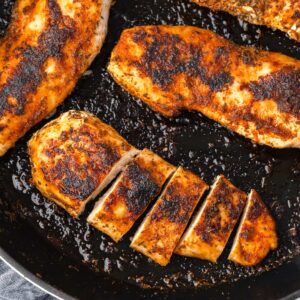
Cast Iron Skillet Chicken Breast
Equipment
- cast iron skillet
Ingredients
- 2 large pieces boneless skinless chicken breasts
- 2 tablespoons avocado oil
- 1 tablespoon smoked paprika
- 1 teaspoon dried thyme
- 1 teaspoon dried oregano
- 1 teaspoon garlic powder
- 1 teaspoon onion powder
- 1 teaspoon salt
- 1/4 teaspoon black pepper
Save This Recipe
You'll join my email list which you will love. And if you don't, unsubscribe in one click. ❤️
Instructions
- Prep chicken. Place each chicken breast flat on a cutting board and carefully slice horizontally to create two thin cutlets (4 pieces total). Pat all chicken pieces thoroughly dry with paper towels.
- Make seasoning . In a small bowl, combine smoked paprika, dried thyme, dried oregano, garlic powder, onion powder, salt, and pepper.
- Season generously. Coat both sides of each chicken piece with the blackening seasoning, pressing gently to adhere.
- Preheat pan. Heat cast iron skillet over medium-high heat until very hot, about 5 minutes.
- Add oil. Add avocado oil to the hot pan and swirl to coat the surface.
- Cook first side. Carefully place seasoned chicken in the hot skillet (work in batches if needed). Cook for 3-4 minutes until a dark crust forms.
- Flip and finish cooking. Turn chicken and cook another 3-4 minutes until cooked through (internal temperature 165°F).
- Brief rest. Remove chicken from skillet and let rest for 3 minutes before serving to redistribute juices.
Notes
Nutrition



More to Explore
Simple Homemade Marinara
How to Make Garlic Powder in a Dehydrator
Homemade Spiced Apple Rings (For Canning)
Red Hot Cinnamon Pickles (Canning Recipe)